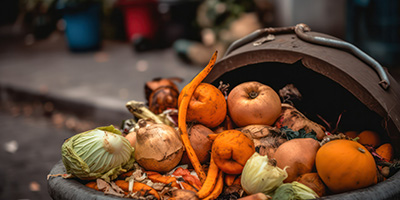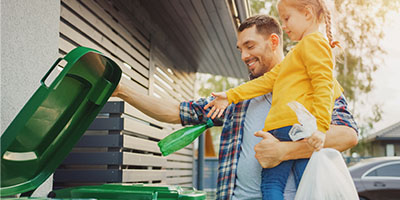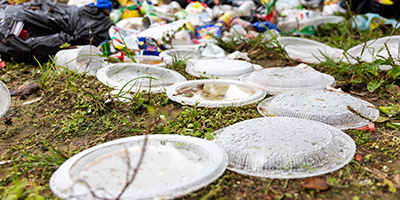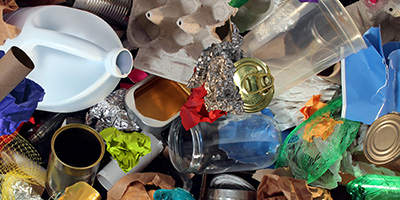Is Single-Stream Recycling Worth It?
Make the most of your household recycling program with these tips to avoid contamination and streamline sorting.
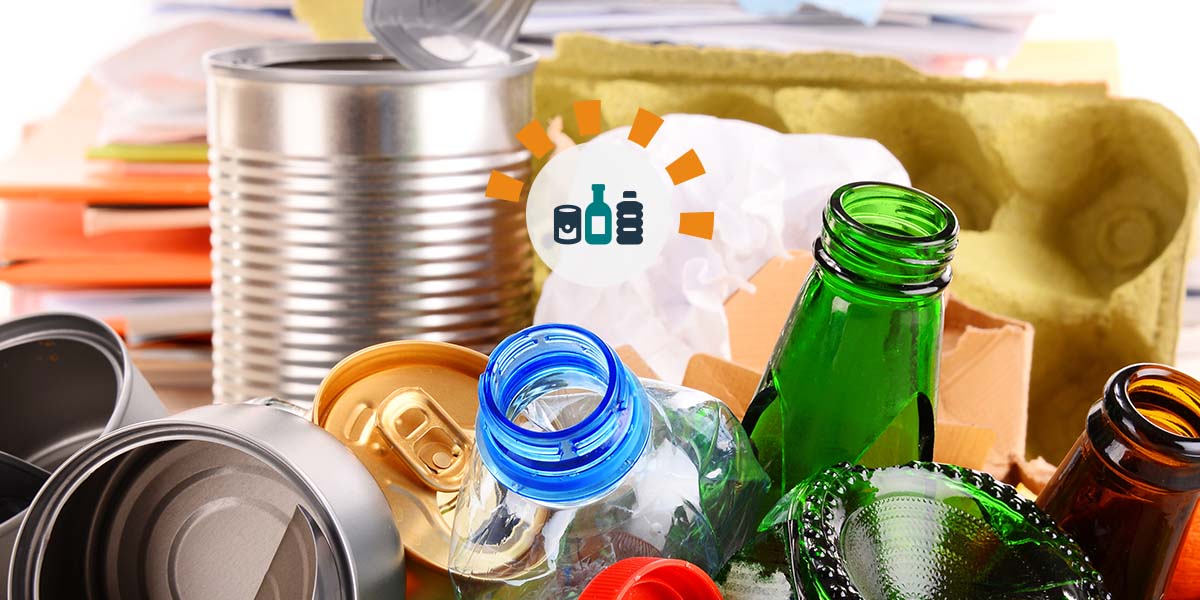
Single-Stream Recycling: Balancing Quality and Convenience
It sounds easy enough: throw all of your recyclable items into a blue bin to take out on recycling day. But what happens if a glass bottle breaks? Or you forgot to break down that greasy pizza box?
Single-stream recycling makes it simple for consumers to recycle. You no longer have to sort paper, plastic, cardboard and glass into separate containers to take to the curb. In theory, this should increase recycling and diversion rates. However, the convenience may come at a cost. Confusion about what can and can’t be recycled along with contamination leads to issues at recovery facilities.
To sort out the pros and cons, we spoke to Mitch Hedlund from Recycle Across America and Kara Pochiro from the Association of Plastic Recyclers.

"Although mixed recycling (single-stream) isn’t ideal for the porous recyclables such as paper, cardboard and glass materials, it isn’t the reason for the crisis with recycling. Mixed recycling can work, when people are recycling properly. The greatest amount of contamination comes from ‘garbage’ being thrown in recycling bins in general."
What Is Single-Stream Recycling?
Introduced in the mid-1990s, single-stream recycling is a process that doesn’t require consumers to do any sorting. All recyclable items are placed in the same bin and mixed in the collection truck. These materials are later sorted out at a Materials Recovery Facility (MRF). This method is also called commingled or single-sort recycling.
There are two main reasons single-stream recycling has become so popular:
- Its convenience encourages more people to recycle.
- It reduces collection costs for curbside waste disposal companies.
What Items Are Accepted in Single-Stream Recycling Programs?
While there may be restrictions in some areas, most programs accept the following items:
- Plastic bottles
- Paper
- Cans
- Clean aluminum foil
- Cardboard
- Paper bags
- Glass jars and containers
- Magazines, catalogs and newspaper
- Empty prescription drug bottles
- Steel cans
- Paperboard
It’s always best to check with your city’s Public Works department or recycling company to learn exactly what’s recyclable in your area.

"Communities work with their MRF to determine what can be collected and sorted at their facility. The most common programs collect #1, 2 and 5 plastics, aluminum, steel, paper, cardboard and glass."
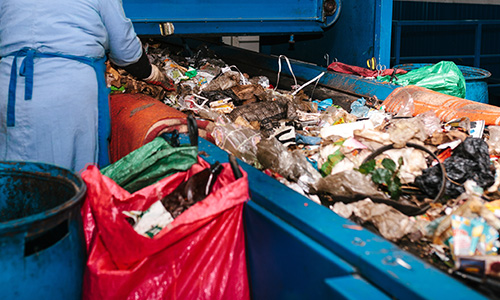
How Does Single-Stream Recycling Work?
Once recyclables are placed in curbside bins, collection trucks bring the materials to the floor of an MRF. There, machines and employees divide all the materials into categories. Sorting methods can vary between different facilities, but conveyor belts, screens, forced air, magnets and scanners are all used to identify and group materials together.
The Commingled Recycling Sorting Process:
- Materials are unloaded from trucks and placed onto a conveyor belt, where employees remove all non-recyclable items manually.
- Recyclable items are transferred onto a series of deck screens. Here, heavier items drop through to the bottom screens and leave paper, cardboard and lighter materials at the top.
- Heavy materials are sent under a magnet to remove metal items like cans or tins.
- Staff at the recovery facility double-check to ensure items are in the right path and sorted in the appropriate category.
- Workers sort everything on the light layer of screens into separate containers for paper, cardboard and newsprint.
- Items are placed in assigned bins and shipped to a recycling facility to be processed into new material.
How Effective Is Single-Sort Recycling?
While it’s convenient for consumers to toss everything in the same bin, the sorting process for single-stream recycling isn’t perfect. Contamination is a common issue because machines and employees at recovery facilities can make mistakes. The end result is often a lower-quality recycled product, and in some cases, a contaminated batch must be sent off to the dump.

"Single-stream recycling definitely leads to more material being collected, but there are issues with contamination. People are often confused about what exactly they should put in their cart, and if items are highly contaminated they can’t always be recycled. Package design is also an issue. Many packaging components can affect recyclability."
Pros and Cons of Single-Stream Recycling
Pros | Cons |
|---|---|
Easy for consumers to participate in recycling programs. | Increase in contamination of recyclables at recovery facilities. |
Increases diversion and recycling rates. | Manual sorting and special equipment required at MRFs. |
Efficient collection as trucks accept all items. | Lower quality of recycled materials due to mixed collection. |
Allows MRFs to process more materials in a shorter period of time with the help of technology. | Difficulties recycling all items due to material flaws like broken glass or non-rinsed bottles. |
Decreased garbage collection costs. | Increased cost to sort commingled material. |
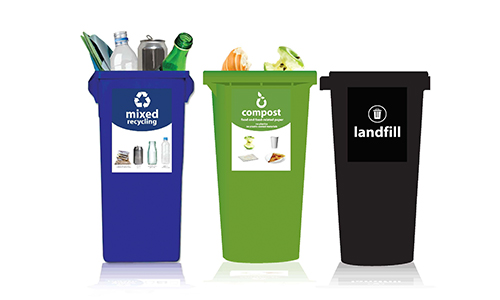
Image courtesy of Recycle Across America
How to Avoid Single-Stream Recycling Contamination
To help recycle right, Hedlund says to do the following:
- Always recycle every empty metal can, plastic bottle and jug.
- Place clean paper and newspaper in a paper bag before putting it in the recycling bin.
- Only recycle empty glass bottles and jars.
- Never put plastic bags or plastic wrap in the recycling bin.
- Don't dispose of any food waste, dishware or drinkware in a single-stream recycling container.
- Pay attention to labels, and place standardized versions on bins you use to avoid confusion.

"Most of the densely populated areas of the U.S. migrated to the mixed recycling (single-stream) system and now we have to live with it for a while. Therefore, it’s absolutely critical that we make it easy for the public to start recycling right."
Is Single-Stream Recycling Here to Stay?
Although no system for recycling is perfect, single-stream majorly impacts cities that have adopted it as part of their waste management plan. The U.S. recycling rate has grown in leaps and bounds due to the recycling method.
However, that growth rate has slowed over the last decade, coinciding with a contamination rate that has jumped nearly 18%.
The name of the game with recycling and sustainability practices is progress. Single-stream recycling pushed us a step forward by making the behavior more accessible. To keep it sustainable and worth the additional cost to sort, the next move is to further educate our communities. Check out some more helpful tips and tricks below.
Expert Contributors

Mitch Hedlund
Mitch took her 20 years in marketing, communications and branding and started Recycle Across America and the standardized label initiative in 2009. Based in the suburbs of Minneapolis, her knowledge has been featured in many prominent publications such as the New York Times and USA Today. She has also been the keynote speaker at national and international conferences, including the European Union's Environmental Summit and the U.S. Zero Waste Conference.

Kara Pochiro
Kara brought a lifetime of communications work to The Association of Plastic Recyclers. The APR, based in Washington, D.C., is an international trade association that acts as the voice of plastics recycling. Kara is responsible for the overall management of APR communications, media relations, conferences and programs, including the promotion of technical, educational market development and legislative efforts of the association.
Kara is an Ohio University graduate and holds a Master's Degree from Columbia College. She currently resides in Anderson, SC, a suburb of Greenville.
Other Sources
Koerth, M. (2019, January 10). The Era of Easy Recycling May Be Coming To An End. Retrieved from fivethirtyeight.com
Single Stream Recycling. (n.d.) Retrieved from container-recycling.org
What Do You Think?
Does your city offer single-stream recycling? We're listening. Head over to Twitter or Facebook,
and use #dumpstersblog to join the conversation.


